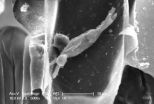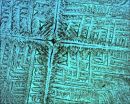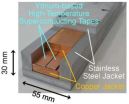(Press-News.org) Insecticides similar to nicotine, known as neonicotinoids, were found commonly in streams throughout the Midwest, according to a new USGS study. This is the first broad-scale investigation of neonicotinoid insecticides in the Midwestern United States and one of the first conducted within the United States.
Effective in killing a broad range of insect pests, use of neonicotinoid insecticides has dramatically increased over the last decade across the United States, particularly in the Midwest. The use of clothianidin, one of the chemicals studied, on corn in Iowa alone has almost doubled between 2011 and 2013.
"Neonicotinoid insecticides are receiving increased attention by scientists as we explore the possible links between pesticides, nutrition, infectious disease, and other stress factors in the environment possibly associated with honeybee dieoffs." said USGS scientist Kathryn Kuivila, the research team leader.
Neonicotinoid insecticides dissolve easily in water, but do not break down quickly in the environment. This means they are likely to be transported away in runoff from the fields where they were first applied to nearby surface water and groundwater bodies.
In all, nine rivers and streams, including the Mississippi and Missouri Rivers, were included in the study. The rivers studied drain most of Iowa, and parts of Minnesota, Montana, Nebraska, North Dakota, South Dakota, and Wisconsin. These states have the highest use of neonicotinoid insecticides in the Nation, and the chemicals were found in all nine rivers and streams.
Of the three most often found chemicals, clothianidin was the most commonly detected, showing up in 75 percent of the sites and at the highest concentration. Thiamethoxam was found at 47 percent of the sites, and imidacloprid was found at 23 percent. Two, acetamiprid and dinotefuran, were only found once, and the sixth, thiacloprid, was never detected.
Instead of being sprayed on growing or full-grown crops, neonicotinoids can be applied to the seed before planting. The use of treated seeds in the United States has increased to the point where most corn and soybeans planted in the United States have a seed treatment (i.e., coating), many of which include neonicotinoid insecticides.
"We noticed higher levels of these insecticides after rain storms during crop planting, which is similar to the spring flushing of herbicides that has been documented in Midwestern U.S. rivers and streams," said USGS scientist Michelle Hladick, the report's lead author. "In fact, the insecticides also were detected prior to their first use during the growing season, which indicates that they can persist from applications in prior years."
One of the chemicals, imidacloprid, is known to be toxic to aquatic organisms at 10-100 nanograms per liter if the aquatic organisms are exposed to it for an extended period of time. Clothianidin and thiamethoxam behave similarly to imidacloprid, and are therefore anticipated to have similar effect levels. Maximum concentrations of clothianidin, thiamethoxam and imidacloprid measured in this study were 257, 185, and 42.7 nanograms per liter, respectively.
The U.S. Environmental Protection Agency has classified all detected neonicotinoids as not likely to be carcinogenic to humans.
INFORMATION:
The paper, "Widespread occurrence of neonicotinoid insecticides in streams in a high corn and soybean producing region, USA" and has been published in Environmental Pollution. Learn more about the study and the long-term USGS effort to gather information on the environmental occurrence of new pesticides in different geographic, climatic, and use settings here. To learn more about USGS environmental health science, please visit the USGS Environmental Health website and sign up for our GeoHealth Newsletter.
Corn and soy insecticides similar to nicotine found widespread in Midwest rivers -- USGS news
2014-07-25
ELSE PRESS RELEASES FROM THIS DATE:
Zerenex (ferric citrate) long-term Phase 3 study results published in JASN
2014-07-25
New York, NY - July 24, 2014 -- Keryx Biopharmaceuticals, Inc. (Nasdaq:KERX) (the "Company") announced the publication of results from the long-term, randomized, active control Phase 3 study of Zerenex (ferric citrate), the Company's investigational oral ferric iron-based phosphate binder, for the treatment of hyperphosphatemia in patients with end-stage renal disease (ESRD) on dialysis. The PERFECTED study (PhosphatE binding and iRon delivery with FErric CiTrate in EsrD) was published online today in the Journal of the American Society of Nephrology (JASN).
This Phase ...
New hope for powdery mildew resistant barley
2014-07-25
New research at the University of Adelaide has opened the way for the development of new lines of barley with resistance to powdery mildew.
In Australia, annual barley production is second only to wheat with 7-8 million tonnes a year. Powdery mildew is one of the most important diseases of barley.
Senior Research Scientist Dr Alan Little and team have discovered the composition of special growths on the cell walls of barley plants that block the penetration of the fungus into the leaf.
The research, by the ARC Centre of Excellence in Plant Cell Walls in the University's ...
NRG1 isoforms could be an effective therapeutic candidate to promote peripheral nerve regeneration
2014-07-25
Neuregulin 1 (NRG1) is a pleiotropic factor characterized by the existence of numerous isoforms arising from alternative splicing of exons that confer to the protein deeply different characteristics. NRG1 plays an important role for both the myelination occurring during development and the different phases occurring after injury in the peripheral nerve: axon degeneration, axon regrowth, remyelination and target reinnervation
Researchers at the University of Western Australia have discovered that the soluble NRG1 upregulation observed in Schwann cells immediately after ...
Assessment on self-care ability of children with spina bifda
2014-07-25
Spina bifda (SB) is a complex congenital central nervous system disease that is caused by the incomplete closing of the neural tubes during the embryonic phase. Many patients have varying degrees of spasticity, urinary and fecal incontinence and neurocognitive retardation. Such problems decrease the patients' functional independence and their quality of life. Researchers at Ankara Physical Medicine and Rehabilitation Education and Research Hospital, Turkey investigate the functional performance in children with SB, using the Pediatric Evaluation of Disability Inventory ...
Neurologic recovery from corticospinal tract injury due to subfalcine herniation
2014-07-25
After development of diffusion tensor tractography (DTT), which is derived from diffusion tensor imaging (DTI), three-dimensional reconstruction and estimation for three motor tracts, such as the corticospinal tract, the rubrospinal tract, and the corticoreticular pathway became possible. The corticospinal tract is known to be a major neural tract for motor function in the human brain. Several studies have reported on injury of the corticospinal tract by transtentorial herniation. In addition, some studies have demonstrated recovery of a corticospinal tract injured by transtentorial ...
Bacteria manipulate salt to build shelters to hibernate
2014-07-25
For the first time, Spanish researchers have detected an unknown interaction between microorganisms and salt. When Escherichia coli cells are introduced into a droplet of salt water and is left to dry, bacteria manipulate the sodium chloride crystallisation to create biomineralogical biosaline 3D morphologically complex formations, where they hibernate. Afterwards, simply by rehydrating the material, bacteria are revived. The discovery was made by chance with a home microscope, but it made the cover of the Astrobiology journal and may help to find signs of life on other ...
Breakthrough laser experiment reveals liquid-like motion of atoms in an ultra-cold cluster
2014-07-25
A new study by researchers from the University of Leicester has furthered our understanding of how tiny nanosystems function, unlocking the potential to create new materials using nanosized 'building blocks'.
The study, which has been published in the prestigious academic journal Physical Review Letters, used a novel laser technique to examine in rich detail the structure and internal atomic motion of a small cluster containing an acetylene molecule and a single helium atom.
The technique excited single clusters and generated rotational wavepackets, which are composed ...
Magnets for fusion energy: A revolutionary manufacturing method developed
2014-07-25
The National Institute for Fusion Science (NIFS), of the National Institutes of Natural Sciences (NINS) in Japan, has achieved an electrical current of 100,000 amperes, which is by far the highest in the world, by using the new idea of assembling the state-of-the-art yttrium-based high-temperature superconducting tapes to fabricate a large-scale magnet conductor.
NIFS is undertaking the development of a high-temperature superconducting coil that is appropriate for the fusion reactor magnet. Using the state-of-the-art yttrium-based high-temperature superconducting tapes ...
Physicists create tool to foresee language destruction impact and thus prevent it
2014-07-25
There have been numerous cases of cultural changes throughout history. Either by imposition or assimilation, cultural traits are transmitted between neighbouring regions and often one replaces the original cultural traits of the other. Physicists Joaquim Fort, from the University of Girona (UdG), and Neus Isern, from the Universitat Autònoma de Barcelona (UAB), are experts in modelling these phenomena by adequately representing a reality, as they have demonstrated with their previous projects.
In this occasion, the researchers applied their expertise to the area of language ...
Collecting just the right data
2014-07-25
Much artificial-intelligence research addresses the problem of making predictions based on large data sets. An obvious example is the recommendation engines at retail sites like Amazon and Netflix.
But some types of data are harder to collect than online click histories —information about geological formations thousands of feet underground, for instance. And in other applications — such as trying to predict the path of a storm — there may just not be enough time to crunch all the available data.
Dan Levine, an MIT graduate student in aeronautics and astronautics, and ...




